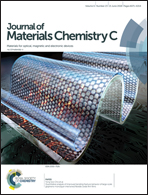Photophysics behind highly luminescent two-dimensional hybrid perovskite (CH3(CH2)2NH3)2(CH3NH3)2Pb3Br10 thin films†
Abstract
Two-dimensional (2D) Ruddlesden–Popper perovskites have emerged as a new class of hybrid materials with high photoluminescence and improved stability compared to their three-dimensional (3D) counterparts. Studies of the photophysics of these new 2D perovskites are essential for the fast development of optoelectronic devices. Here, we study the power and temperature dependences of the photoluminescence properties of the (PA)2(MA)2Pb3Br10 hybrid perovskite. High electron–phonon coupling near room temperature was found to be dominated by longitudinal optical (LO) phonons via the Fröhlich interaction. However, we show that the presence of free carriers is also possible, with lower trapping states and higher and more stable emission compared to the 3D MAPbBr3. These characteristics make the studied 2D material very attractive for optoelectronic applications, including solar cells and light emitting diodes (LEDs). Our investigation provides new fundamental insights into the emission characteristics of 2D lead halide perovskites.



 Please wait while we load your content...
Please wait while we load your content...